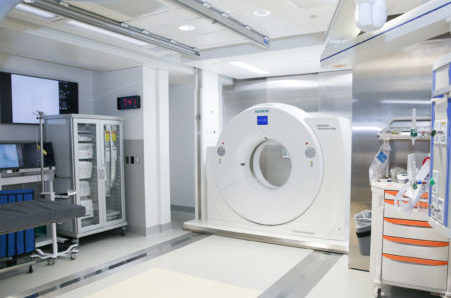
At a Glance
- UVA recently opened two angiography operating suites that share a single CT scanner on rails.
- Having intraoperative access to real-time CT scans leads to better treatment, especially for patients with complex conditions.
- The enhanced visualization offered by the intraoperative CT scan helps ensure chemotherapy is delivered to the appropriate location, is critical in the treatment of vascular disease and more.
As an interventional radiologist, J. Fritz Angle, MD, uses minimally invasive techniques to treat complex vascular diseases and cancer in the liver, kidney and bones, as well as to maintain proper dialysis access and drain tissue of excess fluids. His practice requires him to thread catheters through networks of blood vessels and insert needles at exact locations while avoiding vital structures.
While 2D conventional fluoroscopy in the operating room is suitable for many of these situations, it cannot produce the contrast and resolution required for the most difficult cases. This kind of precision, however, can be achieved with a CT scanner. CT scans eliminate the overlap characteristic of X-rays. Instead, they provide cross-sectional slices of the anatomy, enabling radiologists to more easily distinguish between different kinds of tissue and see them in more detail.
That’s why the decision by UVA Health to open a pair of angiography operating suites that share a single CT scanner on rails is such a breakthrough. Simply opening a CT-angio hybrid operating room is newsworthy — this can be found at just a few dozen medical centers around the United States — but creating a set of rooms served by a single CT scanner is unprecedented.
“In one stroke, this arrangement moves UVA to the forefront of medical centers capable of performing procedures that would not be possible without an intraoperative CT scanner,” Angle says. “It is especially important for a specialty care center like UVA where we treat patients with complex conditions.”
Conducting Complex Procedures Safely
The two arterial catheterization operation suites are part of a bank of 16 recently opened, hybrid operating rooms at UVA, which has embraced intraoperative imaging. Why? Because having intraoperative access to real-time CT scans leads to better treatment, Angle says. He notes that it is particularly useful, for instance, in treating patients with liver cancer. “With traditional fluoroscopy, it can be difficult to distinguish the tumor from healthy tissue,” Angle says. “Having a CT scan improves our ability to deliver chemotherapy to the correct location, improving results.”
Intraoperative CT scans are also critical in treating vascular disease, especially if there are abnormal structures in the vasculature. “CT scans enhance our ability to see our path into the structure,” Angle says. “It enables us to perform procedures we might not have done otherwise and to do so safely.”
Doubling Down on Treatment
The dual-operating room arrangements has benefits for the health system as well. Having a single machine running on rails between two rooms effectively doubles the benefits of CT scanning without doubling the investment. This arrangement also increases utilization. For instance, it creates additional flexibility in making CT scanning available for the emergency department. The arrangement also sets the stage for greater collaboration between interventional radiology and such disciplines as vascular surgery, cardiovascular surgery, oncology, transplantation, urology and gastroenterology, with more to come.
“Of course, this equipment is only as good as the team that runs it,” Angle says. “UVA has a premier interventional radiology technologists training program, and our staff have expanded their skill set to operate these new complex rooms.”
The UVA approach is so novel that Angle expects colleagues from other institutions will visit UVA to see firsthand the benefits of its dual-room CT scanner. “This set of hybrid operating suites were five years in the planning,” Angle says. “In terms of the expanded care they will enable, it was well worth the effort. We hope that we can set an example for other medical centers to follow.”
To refer a patient to UVA interventional radiology, call UVA Physician Direct at 800.552.3723.
See the CT on rails in action in the video below: